How to Replace Your Wheel Bearings
- BP team
- Feb 17, 2021
- 8 min read
Updated: Apr 12, 2022
Have you checked the play in your wheels recently?
As daunting as it sounds for the novice, replacing your wheel bearings is something anyone can do with a few basic tools and the right knowledge for your bike.
This article presents the universal principles applicable to any bike and includes detailed instructions for the Suzuki DR650.
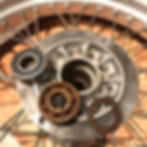
A seasoned off-road rider knows this is something to pay attention to regularly.
If you are a novice motorcycle mechanic, learn that riding off-road puts your bike's components, like bearings, through a lot of mechanical stress due to water, dirt, salt, etc., getting into all the nooks and crannies.
Even though the manufacturers do their best to come up with a design that keeps things reliable for a decent amount of time, wheel bearings are considered consummable parts, like your chain or brake pads, when you ride off-road.
First, let's look at bearings individual components.

It's basically three parts, the outer race, the inner race, and the balls in between.
Sealed bearings have the balls hidden behind a seal. The rubber type can be removed to regrease the bearing.
See our article dedicated to regreasing a good bearing: How to Repack a Wheel Bearing.
The thing to always remember is never to apply forces that could move one race but not the other, to avoid unwanted damage.
The bearings used in motorcycle wheels are a type called deep groove ball bearings.
They are designed to handle huge radial loads (the bike's weight or any force applied in the vertical plane), but they are not great for any axial load.
Meaning, it's crucial to install a new set and be very careful not to apply any force on the inner race and respect the installation method for your bike.
If you do it wrong, you will slightly crush the balls or keep them under axial load, and the bearings won't last long. Even a "standard quality bearing," when properly installed, will work well for a decent amount of time. You can read many complaints about this or that brand not being "good," but most of these issues are probably due to poor installation.
Check our store for a Front-wheel kit in standard quality and high-performance and a Rear-wheel kit in standard and high quality. We also carry the sprocket holder bearing individually in a standard and high-performance kit.
The (inexpensive) tools for the job
If you browse a large online store like FortNine, Revzilla, or Rocky Mountain ATV/MC, you will find many offers for wheel-bearing tools. Some are described as a remover set, other as driver set, with the common feature being expensive ($80 to $130 for those kits). None of them are necessary. The only ones you might need to buy to complete your basic toolbox, is a large punch and a torch.
For approximately $17, you can get a 5/16"x15" punch or 1/4" by 12" at Princess Auto here in Vancouver, Canada. For you guys in the US, Harbor Freight and similar affordable hardware stores will stock these tools.
As for the torch, the small culinary or electronic ones won't cut it, but affordable "heads" can be found like those that fit on the little green propane cylinders that we use for portable BBQs. There's no need for the kind that requires a special cartridge (butane).
They only burn hotter, and it isn't needed for mechanical jobs.
Here is the complete tutorial on replacing your bearings on Suzuki DR650
Tools and supplies needed.
Wrenches: size 10mm, 19mm, and 24mm to take the wheels off;
a large flat-tip screwdriver;
a hammer;
a large punch or long solid rod;
a torch;
a large socket slightly smaller than your bearings outer race;
thick washers matching your bearings outer race;
brake cleaner;
grease;
rags/shop towel; and
gloves.
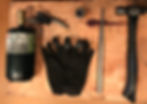
Step 1: Accessing the bearing
Once you have the wheels off the bike, remove the spacers by pulling them out.
A little lip on the spacer holds it in place so that they don't fall off when taking the wheel off for repairs, but they come out with a little persuasion.
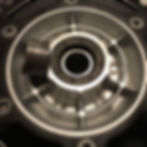
Now with the large flat-tip screwdriver, carefully pry the dust seal out. The correct way to do this is to push the flat tip as far as possible (against the hub) underneath the seal.
You want to ensure you are prying on the outer edge of the seal (metal reinforced). This will be more effective. Since your wheel bearing kit includes new ones, the old one will go in the trash anyway.
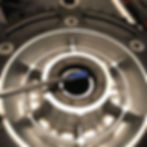
You will see the bearing with the dust seal removed (with either a black, red or blue seal). Clean the face of the bearing with a rag to remove dirt and grease, if any.
On DR650, you will find:
Front-wheel with only one dust seal on the disc side and two identical bearings, one on each side.
Rear-wheel with one seal to remove on the disc side and one seal to remove on the sprocket holder (pictured above) that comes off the hub. No seal on the chain side of the hub, only a spacer behind the sprocket holder. There are three bearings: two bearings in the hub and one slightly larger in the sprocket holder.
Step 2: Removing the bearings
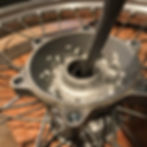
There is a spacer in between both bearings inside the hubs (front and rear wheels). This long spacer is here to take the axial load of both inner races or actually avoid it when you tighten the wheel back on the bike.
This our preferred method to remove bearings. It's fast, simple, and easy compared to any specialty bearing removal tool.
1. Set up the hub edges on a stable surface, on two pieces of wood apart to have room for the bearing to drop.
2. Heat the hub around the bearing (not the bearing itself) with the torch for a few minutes. This will greatly help them come out with little hammering and prevent wearing out the inner surface where they sit.
Note: Over time, when you replace bearings, the bore is scraped away (especially doing it cold), and the opening gets larger--not good! Eventually, your bearings won't be held as tight as they should.
3. Slide your punch inside the upper bearing toward the bearing close to the table. Then, place the tip against the edge of the opposite bearing's inner race by pushing the spacer on the side as pictured below.

4. Once on edge, hit the punch with the hammer and repeat on the opposite side. Rotate 90°, repeat, opposite side, etc. The idea is to push it straight out, so only one good bang per position is necessary. The bearing should drop in as little as 4 to 6 hits when you heat the hub.
Note: You can use this technique on any bearing if you can reach it from behind and get the punch on the edge of a race. All bearings removed by hitting/pulling on one race in this manner should be discarded right away. Do not reuse them. They have been damaged (balls slightly crushed) and will fail prematurely.
Step 3: Installing the bearings
This isn't as straightforward for the novice but easy once you know the right technique. We will cover what we feel the best way, but some other methods and tools achieve the same outcome.
Pounding the bearing fully seated on both side of the hub is the best way to ruin them and will guarantee you a short service life!
Here are the principles about bearing clearance you should know about on the DR650.
As described in the first part of that article, we know that those bearing shouldn't have any axial loads. The spacer inside both hubs is longer than the distance between the bore's seat on each side. Meaning, if you carelessly seat the bearings pounding on both sides' outer race, you are effectively crushing the balls through the pressure applied with the spacer on the inner races.
Below is a drawing of what you will easily achieve with our method. On one side only, the bearing is fully seated in the hole, while on the other side, the bearing isn't.
There is an amount of clearance defined as "just until the inner race touches the spacer." The spacer has to be snug in between the bearings but nothing more.
It easier to describe in words but harder in practice, which is why you read stories online of people complaining that their wheel bearings have a short lifespan.

On DR650, remember this:
Front-wheel, the LEFT bearing is installed first and fully seated.
Rear-wheel, the RIGHT bearing is installed first and fully seated.
The sprocket holder is a single bearing and fully seated.
Note: Other more modern or high-end bikes will have a different procedure due to a different mechanical design, Always check the shop manual for your bike.
We've replaced many bearings and found this to be the fastest and easiest way to do it properly.
1. Prepare the new bearings by applying a thin layer of grease on the outer race and put them in the freezer at least an hour ahead of installation.
2. Place the wheel on a stable surface, hub resting on a solid surface, with the first side up. Inspect the bore where they should go and wipe the area clean.
3. Heat the bore and surrounding area of the hub with the torch for a solid 2-3min.
Then, quickly place the bearing in the hole. It should almost drop-in.
With your socket that matches the outer race (slightly smaller to be accurate), give a few good taps to be sure the bearing is resting all the way down.
4. After waiting a few minutes to cool down, the bearing will be locked in place.
Flip the wheel, slide the spacer in and start heating the hole again for a few minutes.
5. This is where the magic happens! Because you are taking good care of cooling down the bearing and heating the hub, you actually need to use very little force.
This bearing should drop-in, coming in contact with the spacer, snug as needed.
Again, to be sure, quickly drop the matching washer and use a socket on top to give a few hits with the hammer. You will hear a different sound if it isn't seated correctly on the spacer than the sound it makes when it is.
Note: Using the washer here allows you to make sure you are pushing on both inner and outer races at the same time to prevent damage to the bearing.
6. Check that the spacer is snug in between the bearing by moving it sideways with your finger. It should move but not too easily, almost a little difficult with one finger.
Be careful because the hub is still very hot to the touch!
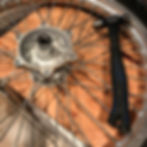
The front and rear hub will be done easily by following this procedure, whereas the single bearing in the sprocket holder is simply fully seated.
This method is faster than using a bearing press tool and allows you to better feel for the clearance by using the full advantage of the contraction/dilatation method.
Step 4: Installing the dust seals
You are almost done. Now let's finish the job with the dust seal.
Tip: It's good practice to apply a layer of waterproof grease on the bearing's outer face to add extra protection against water ingress.
While you do that, allow a little bit of grease on the hole wall so you can slide the seal in more easily.
Grab the correct seal and push hard with your thumbs on both sides. This should be enough. If needed, hitting the outer edge with a mallet (hard plastic or rubber one, not a metal hammer) should help.
Note: It is critical that you only press the dust seal flush with the edge of the hub.
If you do push it further (like when you use a socket), the seal's lip will ride on the wheel spacer's retaining lip. This will cut the rubber and damage it really quickly and allowing water to ingress toward the bearing.
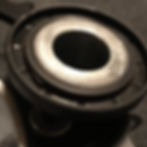
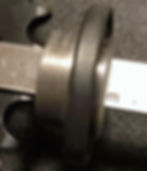
Sometimes, on used bikes, you may find that the seals have been pressed too far in the hub (past flush) or are not the correct thickness (some aftermarket kit). The picture below shows the dust seal install flush on the sprocket holder and the spacer re-install.
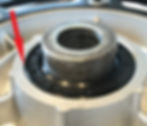
Now, the last thing to do is apply a little bit of grease on the dust seal lip (that little V-shape groove) and put the wheel spacer back.
Repeat the procedure for both wheels and you are now ready to install them back on the bike. Bravo, it's time to enjoy a cold one!
Pro tip: When you buy new bearings, take off the dust seal carefully and add more grease before you install them. They all come with very little grease from the factory which could lead to premature failure. Thanks to Murray B. for this excellent tip!
